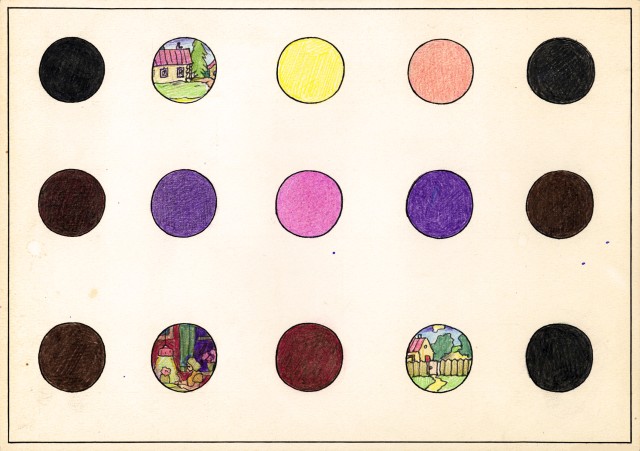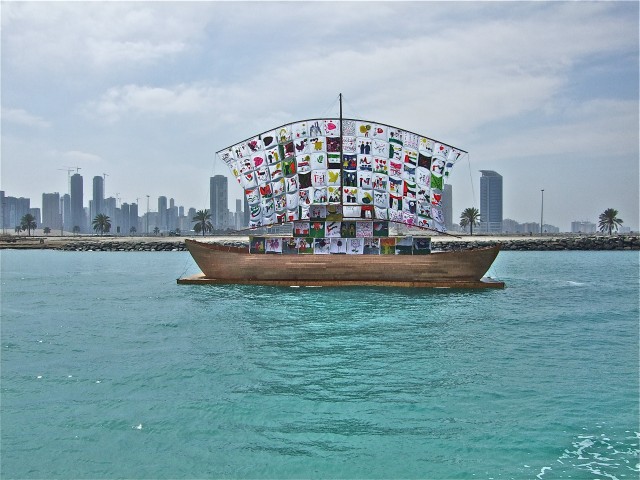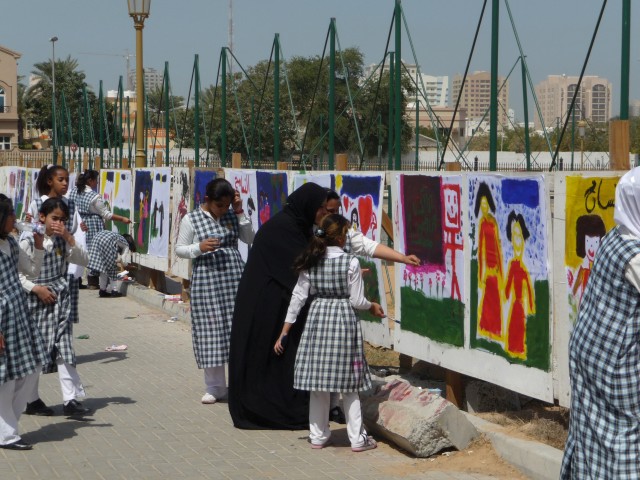by NATASHA KURCHANOVA
Ilya and Emilia Kabakov’s current exhibition at Pace Gallery in New York betrays an expectation of a space we expect to see when we hear the name Kabakov. The time of total installations of the kind of Ten Characters or He Lost His Mind, Undressed and Ran Away Naked mounted at Ronald Feldman Gallery in the late 1980s and early 90s is clearly gone. Then, Ilya Kabakov was a newcomer to the New York art scene with work that immersed the viewer in the atmosphere of surreal Soviet stagnation. Now, more than a quarter of a century later – during which time he settled in the US, began collaborating with his wife Emilia, and acquired the status of one of the most important artists among former Soviet nonconformists – the tone and comportment of his work has changed. No longer setting a stage for a dystopian lifestyle borne by the delusions and failures of the Soviet system, the paintings on view are referencing Soviet visual representation and its history by juxtaposing, in fragments, hypothetical subjects from Soviet life and classical or baroque mythology. The exhibition’s focus on history expands beyond the edge of the canvas. The scope of the works on view embraces drawings with dots or circles from the 1960s album Mathematical Gorsky [part of the 10 Characters series], in which the artist depicts – also in fragments – obsessive dreams of escape by a typical Soviet man who is caught in a Kafkaesque nightmare of late Soviet life.

Ilya & Emilia Kabakov. Two Times Nr. 3, 2015. Oil on canvas, 284.5 x 190.5 cm.
Emilia Kabakov has kindly agreed to speak to Studio International about the exhibition, her collaboration with her husband, and the evolution of his work.
Natasha Kurchanova: I wanted to ask you about your work as an artist. As far as I understand it, you were not involved with visual art before your work with Ilya – that is, from the late 1980s. How did meeting Ilya shape you as an artist?
Emilia Kabakov: To say that “I became an artist” would not be correct. I don’t consider myself an independent artist. Ilya and I always work together. I never do anything by myself. It’s very difficult to explain and this is why I usually refrain from such explanations. People who observe us working together say that, to an outsider, it looks as if we work as one person. I was involved in visual art for many years by the time Ilya and I started to work together. I worked as a curator, art adviser and dealer.

Ilya & Emilia Kabakov. Two Times Nr. 6, 2015. Oil on canvas, 190.5 x 284.5 cm.
NK: I saw Amei Wallach’s documentary, Ilya and Emilia Kabakov: Enter Here. That film reveals rather well the way in which you collaborate.
EK: In the late 80s I started to work with Ilya as an organiser, assistant and translator. Gradually, we began doing projects together. I have difficulty thinking of myself as an artist, because I believe that, to become good at anything, a person should study and practise for a long time. For example, I am a professional musician, and 25 years of my life were given to the study of music. I learned how to play, rehearse, perform – I became a professional as a result of this process. Any art practice requires professional education. I came to visual art through educating myself via books, going to museums and exhibitions, looking at art, thinking, and so one could say that I am a self-taught artist. I have imagination and ideas that are necessary for an artist, but not professional training. I lack this training, and this is why I do not call myself an artist. Many artists do not feel this way, but I do.

Ilya & Emilia Kabakov. Two Times Nr. 7, 2015. Oil on canvas, 190.5 x 284.5 cm.
NK: I suspect you feel this way because you were brought up and educated in the former Soviet Union.
EK: Yes, perhaps. My grandson, for example, practises violin for between four and eight hours per day. This is what I call a standard classical education. In visual arts, training used to be similar to musical training. It’s not any more. For example, I cannot draw as a professionally trained artist. I can draft an architectural project, because I was taught how to do this in high school, but I can draw only in an amateurish way. Ilya is a professional artist; he can draw, paint any kind of painting, he knows art history. His conceptual orientation allows for our collaboration.
NK: Could you tell me about your and Ilya’s exhibition on view at Pace Gallery? It contains your recent paintings and prints from Ilya’s drawings from the 70s. It does not seem to be a typical exhibition, because it does not have a specific theme. It is called simply New Paintings.
EK: This exhibition does have a theme. It is the theme of history turning to art history and the influence that this cultural history has on today’s art. But as usual there are many hidden meanings and insinuations, which a person, depending on their cultural background, will be able to see, feel and recognise. The exhibition has two series of paintings: the first is called The Two Times, and represents scenes from classical subjects juxtaposed with those from imaginary Soviet life, and the second is called the Temporary Loss of Eyesight. It includes representations of idealised life covered by a net of dots. The Two Times series is guided by the idea of art’s fragmentary nature. Ilya wanted to realise this idea for a while, and he’s been working on it for about three or four years already. In the beginning, we took fragments from different periods of art history more or less at random, but now Ilya is turning more towards the baroque. All the images are taken from imagination, of course. It means that the scenes Ilya depicts do not come from specific works, but rather represent general tendencies and devices that characterise a particular style. I have just finished reading a book by [the art critic] Barry Schwabsky in which he says that Kabakov reveals the secondary layer of imagination in these painting in fragments.

Ilya & Emilia Kabakov. Two Times Nr. 9, 2015. Oil on canvas, 75 x 112 in (190.5 x 284.5 cm).
The second series, the Temporary Loss of Eyesight, is, as I mentioned, distinguished by dots covering the surface of paintings. This is not a new theme, because Ilya developed the dots in the 60s, and the early drawings from that period are also on display at Pace Gallery, in the form of prints. So, this series is also, in a way, a reflection on the past work. For example, do you remember Ilya’s paintings decorated with candy wrappers? Those paintings were made in the Soviet Union. The idea was that the artist was decorating the reality that he found too boring to contemplate. The Temporary Loss of Eyesight paintings are about reality that is bright and interesting, but the person’s sight is obscured, and so it is impossible to see it without prejudice. The idea behind this series is that reality can never been seen straight on, but is always obscured either on purpose or by necessity.

Ilya & Emilia Kabakov. Print With Dots #2, 2012. Woodcut, 47 ¾ x 68 ¼ in (121.5 x 173 cm). Edition of 12.
NK: In this exhibition, you placed the early graphic works with dots in order to show the connection between them?
EK: Yes, in 2017 in a retrospective at Tate Modern, we will show old and new works with dots as well.
NK: Is Ilya using photographs or illustrations when he works? When you tell me that he takes his subjects from imagination, does this mean that he does not use any subsidiary images to help him paint?
EK: He uses photographs sometimes, but the fact is that an artist with such rich imagination as his does not need to look at photographs or models. He may use them, but only for inspiration. He does not copy them exactly. He does not represent the reality of what he sees, but uses his imagination to depart from this reality. At the end, it does not really matter if he uses a real model or a photograph while he paints or draws. Besides, old Soviet photographs that he uses sometimes are already not the depiction of reality, but rather the fantasy of the photographer, and can be called staged Soviet reality.

Ilya & Emilia Kabakov. The Six Paintings about the Temporary Loss of Eyesight (In the Room), 2015. Oil on canvas, 44 x 77 in (111.8 x 195.6 cm).
NK: What about installations? Kabakov is considered to be the founder of total installations, but now he seems to be moving away from them – in this exhibition, for example.
EK: Yes, I would agree with this. He began as a straightforward painter because he was trained in a Soviet art school. Then his paintings turned to conceptual art. Then they became paintings done by personages, and these personages entered installations where they also created paintings, which fitted the theme of a particular installation. Now, we see the return of personages who painted these works and also of Kabakov himself as a painter. His paintings stay conceptual because juxtaposition of past and present in a work is a concept, but they are painted by Kabakov, not by an invented character.

Ilya & Emilia Kabakov. The Six Paintings about the Temporary Loss of Eyesight (The Scene at the Square), 2015. Oil on canvas, 44 x 77 in (111.8 x 195.6 cm).
NK: You mentioned a forthcoming retrospective at Tate Modern. What other projects are coming up in the near future?
EK: We have been working on the Tate retrospective for more than a year. It is planned for October 2017. Then it will go to the Hermitage Museum in St Petersburg and the Tretyakov Gallery in Moscow. Also in 2017, we are planning to have an exhibition at the Hirshhorn Museum in Washington. In 2016 or 2017, we will have an exhibition in Dubai at the Leila Heller Gallery. We have also had an exhibition in China, which has just closed. It is going to Japan next. In September 2016, we will exhibit our Ship of Tolerance in Switzerland, after which the project will move to Margate, England. Also next year, we are curating an exhibition from the collection of Giancarlo and Danna Olgiati called From Rodchenko to Kabakov. Several years down the road, we are planning an exhibition at the National Museum in Norway.

Ilya & Emilia Kabakov. The Ship of Tolerance, Shariah, 2011. Photograph: Emilia Kabakov.
НК: Which works will be in the retrospectives?
EK: The retrospectives will have the graphic works from the 1950s to the current time. There will be sculptures and different volumetric projects, as well as paintings and installations, including Labyrinth (My Mother’s Album) from the Tate Modern collection.
NK: Could you describe the Ship of Tolerance in more detail?
EK: The Ship of Tolerance is an interactive multimedia installation, a project that expands in time and space. On the face of it, it is a boat, which is made by Ilya and me. The sail of this ship is made from the children’s drawings on canvas. The subjects of the drawings vary, but revolve around the themes of tolerance and necessity to know and respect values of various races and religions. The project was launched in 2005 in Egypt as the Ship of Siwa. From the very beginning, it involved children and their art. Later, we expanded it in such a way that it was taken to schools where the kids were taught the importance of respect for various cultures and ways of being through art, music and language.

Children Making Drawings for The Ship of Tolerance, Shariah, 2011. Courtesy of Shariah Art Foundation.
This project ran in Venice during the 2007 biennale. It also took place in St Moritz, where it was given the Cartier Award. In 2012, we brought this project to Cuba, where we invited children from Russia and the United States to play in a concert together with the Cuban children. It was the first time since 1958 that American children had travelled directly from the US to Cuba. As part of the same project, supported by the Garage Center for Contemporary Culture, The City of Moscow and the Moscow Multimedia Museum, Cuban and American children travelled to Moscow to perform a concert together with local young musicians. We worked on the musical part with the Spivakov Foundation. Then we brought the same project to Brooklyn, and the concert took place at The New York Historical Society.
Now, we are taking our Ship of Tolerance to Switzerland where 60 schools from all over the country are taking part in it. We are inviting children from refugee centres to museums where they will participate in a cultural programme in connection with the Ship of Tolerance. Apart from making drawings for the ship, the kids’ artwork will be displayed at airports, train stations, hotels and other public places in Switzerland. We are going to meet with children and their parents and talk with them about tolerance and diversity. The Ship of Tolerance will also travel to Margate, with support from the Turner Contemporary, from where it will be taken to London and docked in front of the Tate. Apart from this, we are preparing a special internet project, which will be an extension of the Ship of Tolerance. It will be an interactive programme, where children from different countries all around the world will be able to enter the discussion from their personal computers.
• Ilya & Emilia Kabakov: New Paintings is at Pace Gallery, New York until 23 January 2016.